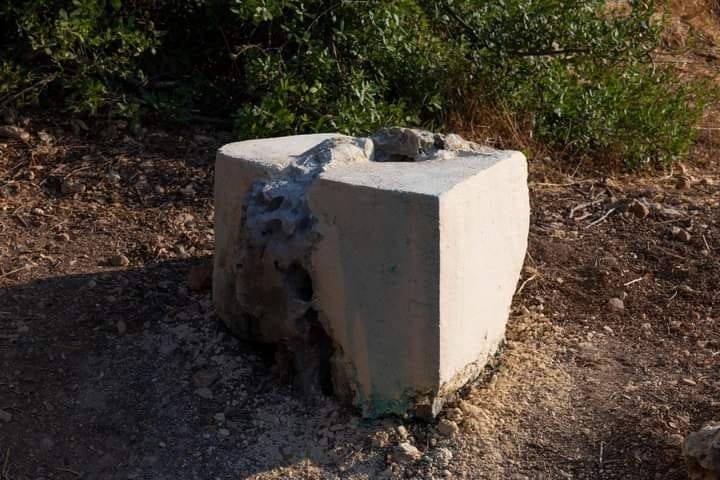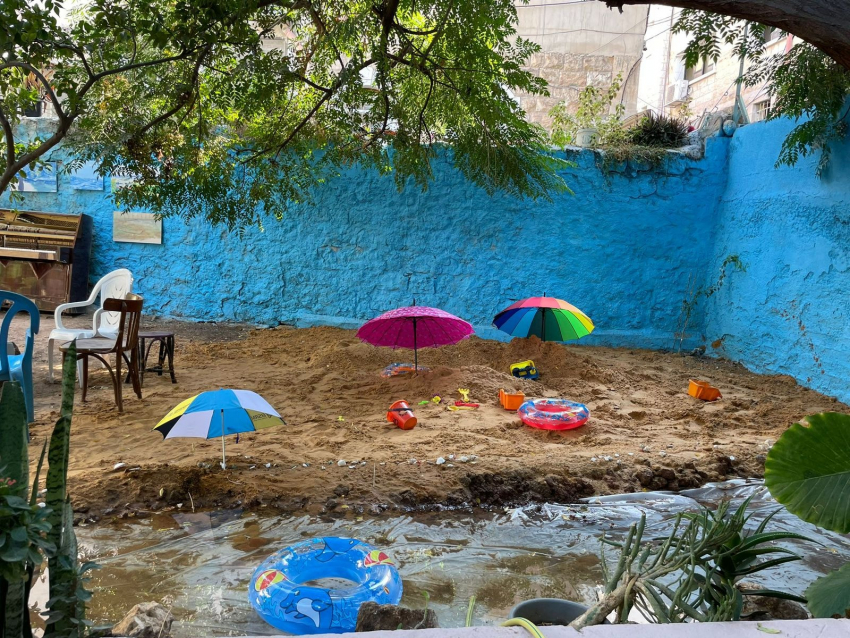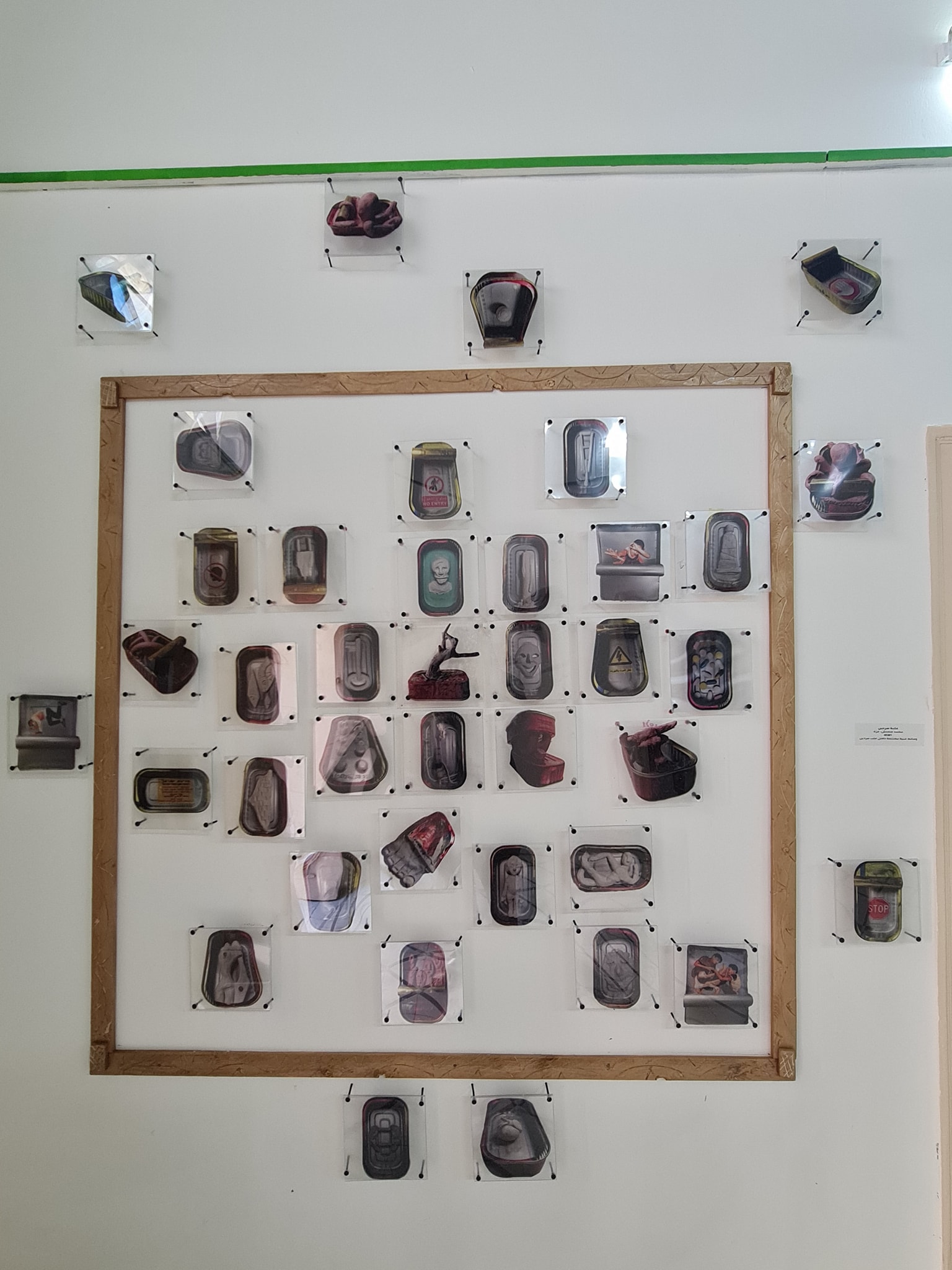

The partners of the second cycle of the “Visual Arts: A Flourishing Field” grant (VAFF) complete the final stages of their projects with exceptional exhibitions featuring artwork created during this partnership.
Within this context, Sakiya – Art/Science/Agriculture launched their exhibition entitled “The Layers Pile” on 4 September at their facilities in Ein Qinya, while Dar Qandeel for Culture and Arts launched their exhibition entitled “From Stone to Sea” on 18 September in Tulkarem.
“The Layers Pile” exhibition explores perception through sensory experiences felt while exploring artwork. It questions the reality of itself and its space, relocating it from a museum or gallery to a neutral site like Sakiya’s facilities. This changes the audience’s experience in perceiving the artwork and space.
The exhibition removes well-known landscape paintings from artificial lighting and relocates them on top of a hill amongst oak trees—a natural setting. It showcases a range of artwork in both two-dimensional and three-dimensional forms by established and emerging artists selected by curator Samar Martha.
“The main theme of the exhibition underscores the use of natural and raw materials to produce the artworks as a way to highlight environmental issues,” says Martha. “Consequently, all the displayed artworks were either inspired by nature or made using natural materials such as mud, wood and clay.” She added.
Despite the difficulties faced when opening exhibitions outside typical spaces, “The Layer’s Pile” exhibition was nevertheless able to promote these valuable works by brilliant artists and attract a large audience. Visitors hiked up a mountain to see the works displayed and still in progress at Sakiya’s facilities. These works were created as part of artist residencies and workshops organised by Sakiya over the past two years.
The house that hosts the exhibition is one of two on the site belonging to the Zalatimo family. The houses were built in different stages, with one from the Ottoman period and the other from the time of the British Mandate. The family used them as summer houses at different times. Artist Dauod Zalatimo, a member of the family, built a wooden shed in the yard in which he produced many of his artworks in the 1940s. The shed is now completely destroyed.
The exhibition featured the artwork of Rafat Assad, who presented two works including “Wadi al-Mijwer” (2021) and included the participation of 12-16-year-old children who were part of a workshop. The children, Rimas, Ayat, Jannat, Taleen Hassouneh and Adi Hamadeen, were part of the “Nature: Between Lived and Imagined Experience” workshop, assisted Ismat Zeid. Artist Lara Salous contributed her works “Pillows” (2021), made of recycled fabric, synthetic foam and threads; and “Chairs” (2021), made of wood. Vera Tamari included four works entitled “A Rocky Study from the Ramallah Hills” (2017) and Taqi Sbateen with “The Light of Olives” (2018) and “The Shadow of Almonds” (2018). Artist Nabil Anani submitted “Composition” (2020), made of cans and metal on wood; Ahmad Canaan with “The Magic Carpet” (2019), made of wood and metal; Sliman Mansour with “A Holy Piece of Land” (1995), made of clay and mixed media on cardboard; and Tayseer Barakat with “Pyrography,” made of wood.
Similarly, the “From Stone to Sea” exhibition presents the audience with the results of an experimental journey taken by Dar Qandeel alongside a large group of artists, youth, children and families. The works were produced over two years through programmes, activities and grants in partnership with curators from the Sada Movement. Sada is a group that includes female students and youth from across Palestine, including the north, the triangle area, Jerusalem and the Naqab, from various artistic disciplines and backgrounds. They aim to shed light on marginal and local Palestinian issues to create change. The movement had previously organised two exhibitions: “Lifta” (2020) and “Maaman Allah Cemetery” (2019). Their previous works intersect with the spirit of the “From Stone to Sea” exhibition in the sense that it “re-unites Palestinian art by bringing together artists from all over Palestine and the diaspora. Visual art is manifested through paintings, installations and video works, forming a mosaic of different practices and ideas,” according to the exhibition statement.
“We tried to see the exhibition through the eyes of the collaborative and independent Dar Qandeel, which required us to produce it using alternative methods. Understanding the artworks unconditionally occasionally demanded that we make interventions that altered the display of the artworks. For instance, this happened with the artwork ‘A Sardine Can’ by Gazan artist Mohammad Jahlash, whose installation works we could not bring from Gaza and reproducing them would have been costly. We eventually resorted to giving the original works a new identity; by installing photos of each sardine can separately behind a double glass slide to create the illusion of a three-dimensional work. The photos were hung on the wall; either framed or expanding outside of the frame. This experience has theoretically created a state of organic fusion between the curator, artist and producer working within an integrated and horizontal decision-making process,” commented Zina Zarour, visual arts programme coordinator at Dar Qandeel.
“This exhibition is the first of its kind at Dar Qandeel as it displayed works by artists from Gaza that were brought in or reproduced for display. Yet we tried to create it economically at the lowest costs. We produced all curatorial interventions at Dar Qandeel’s workshop by recycling various materials using environmentally friendly methods. The curators volunteered to do the work for a symbolic amount. So, we were eventually able to produce the whole exhibition with all its aesthetic considerations at a negligible cost.” She added.
The exhibition showcased these works, including paintings, videos, posters and installations. They were produced through workshops for children, production grants, artist residencies and seminars. Many of the works were also created as part of the “Let’s See” initiative launched by Dar Qandeel in collaboration with the Visual Arts Forum (VAF) during the COVID-19 lockdown. This initiative created a space for families and collectives to discuss that period and express their concerns, boredom and future aspirations through collectively made visual artwork. The exhibition also displays the “Dar Qandeel’s Sea,” built during the “From the Beach of Gaza” online meeting with Shababeek Collective and artists Majdal Nateel and Salman Nuwati, alongside other works about the sea of Gaza painted during the live broadcast of this virtual meeting. The exhibition also showcases mosaic works made by children during the training workshops in Tulkarem and Deir al-Ghusoon.
Additionally, other works were displayed, including “Thirst” by Amani al-Baba from al-Lid in Egypt; “Quarantine Diaries” by Maysara Baroud from Gaza; “Distances” by Salem Awad from Gaza; “Portraits” by Ahmad Saadoun from Gaza; “My Children in Quarantine” by Hiba Zaqout from Gaza; “A Sardine Can” installation by Mohammed Jahlash from Gaza; a collection of posters by the Posters-Factory and Adeeb Hamdan from Ramallah; and “Paintings for +450 Years” installation by Mohammed Bishara from Tulkarem. The exhibition also featured video works, including “Podcast” by Muayyad Abu Ammouneh from Gaza; “Diaries in an Infested Street” by Firas Abu Heibeh; TV episodes entitled “Saba’s Journey” by Jiries Abu Jaber from Bethlehem; and “The Vineyard” project by Shayma Hamad from Hebron, who presented a video and staged a performance. There was also a film screening about the quarantine campaign and the activity carried out by 19 artists to launch it. The campaign included an outdoor landscape painting session of an area of Deir al-Ghusoon in danger of confiscation. An auction to sell these works will be organised with profits going towards Dar Qandeel’s purchase of its headquarters to save it from demolition. Dar Qandeel also seeks to preserve the space as an open cultural centre to host people and community initiatives in the heart of the city.
The exhibition continues its activities by hosting students and organising various tours with the curators from the “Sada Movement.”
Both Dar Qandeel and Sakiya seek to create artistic and cultural activities in marginal areas, far from the centre. Both projects also aim to encourage artists across Palestine to experiment with art production using available resources in working conditions that may not seem comfortable or ideal, and are even poorly resourced.
Both exhibitions are produced as part of Dar Qandeel’s and Sakiya’s partnerships with the VAFF project, funded by Sweden. VAFF supported the implementation of unique art projects organised by the two partners alongside providing institutional support and stability to ensure their sustainability. The project considers these partnerships an opportunity to support the visual arts in areas far from the usual centres of cultural production and push them towards a wider sphere of influence.

